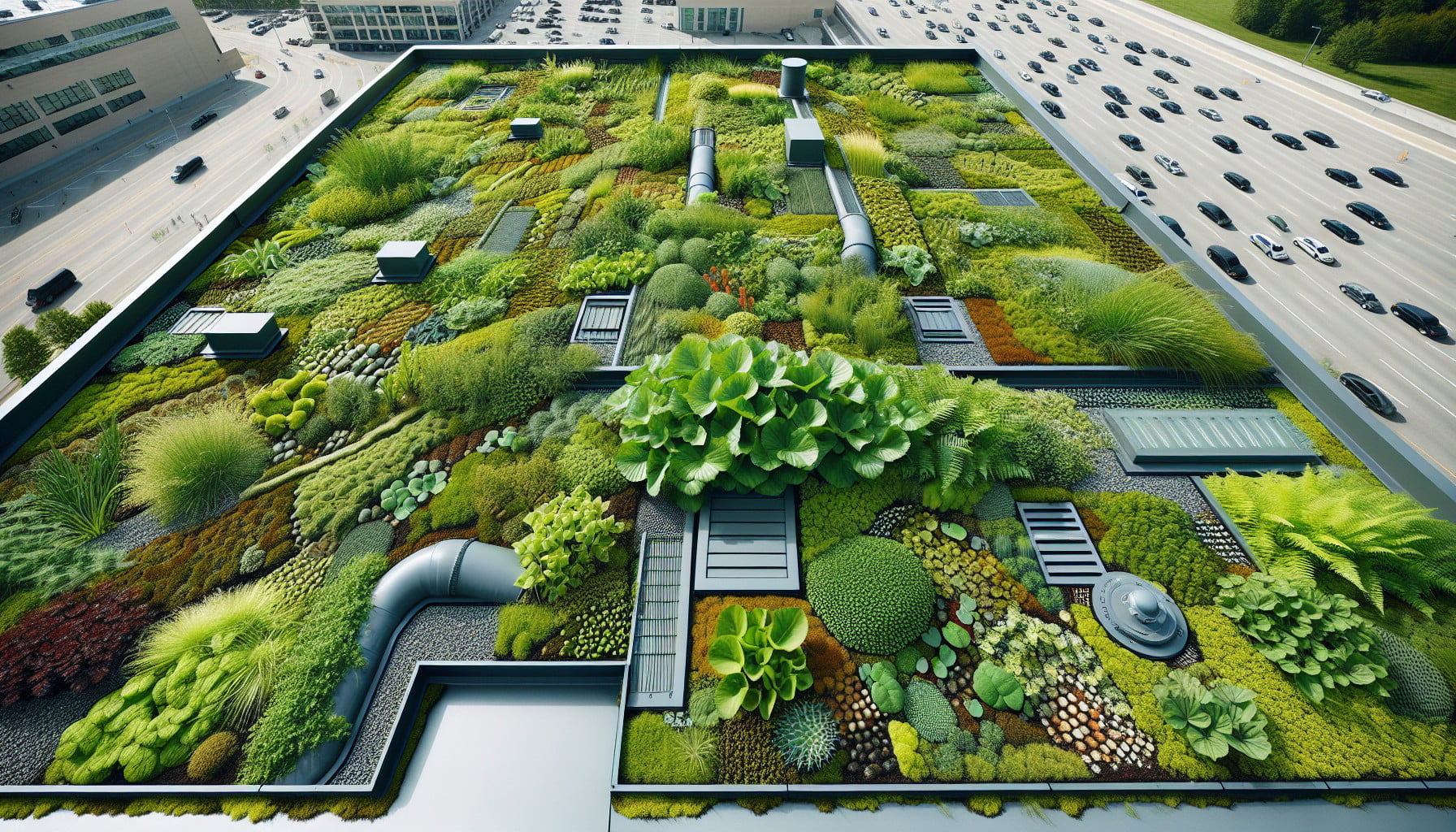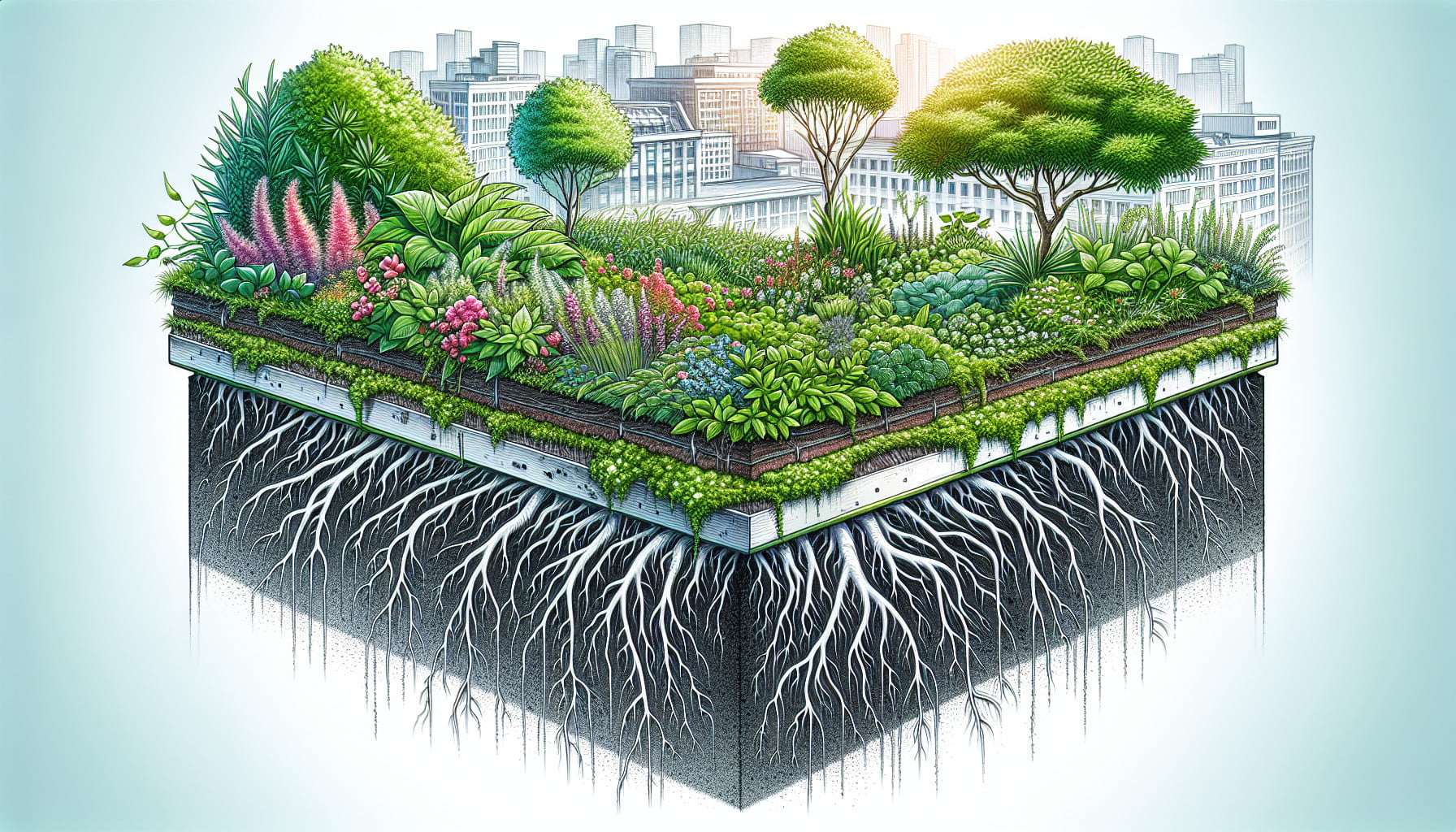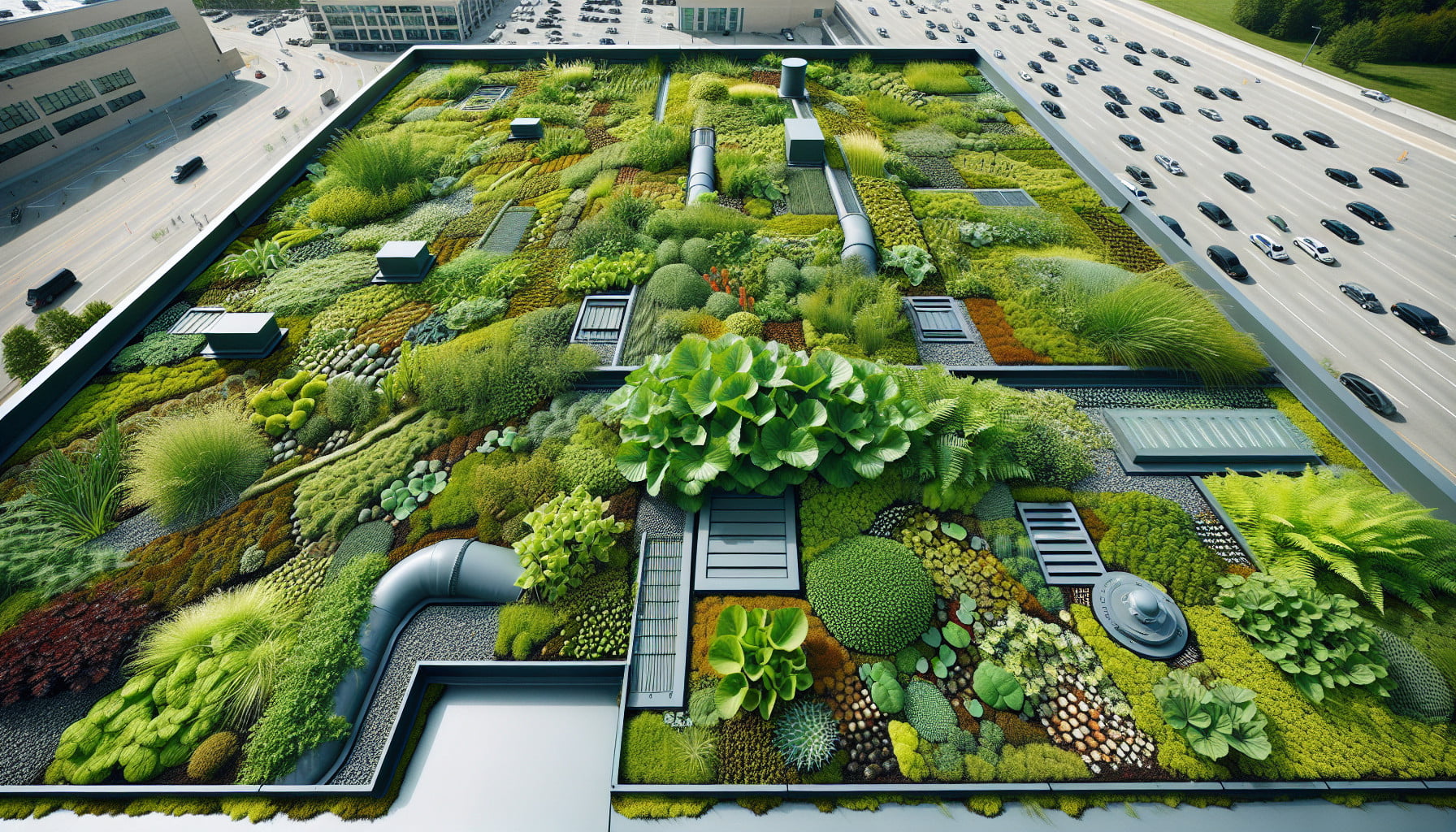You’re in for a treat as we explore the numerous benefits of installing a green roof system. Picture this: a lush oasis on top of your buildings, providing a multitude of advantages not only for you but also for the environment. From reducing energy consumption and stormwater runoff to improving air quality and enhancing urban aesthetics, green roofs are becoming increasingly popular.
So, get ready to discover why installing a green roof system is a smart and eco-friendly choice that can transform your space into a sustainable haven.

Improved Environmental Performance
Reduction of carbon emissions
By installing a green roof system, you can contribute to the reduction of carbon emissions. Green roofs have the ability to capture and store carbon dioxide, a major greenhouse gas responsible for global warming. The plants and vegetation on the roof absorb carbon dioxide during photosynthesis, effectively reducing the amount of this harmful gas in the atmosphere. By choosing a green roof, you are actively taking steps to combat climate change and create a more sustainable future.
Improvement in air quality
Green roofs are also instrumental in improving air quality. The plants and vegetation on the roof act as natural filters, capturing and removing pollutants and particulate matter from the air. They trap dust, pollen, and other airborne particles, reducing their concentration and enhancing the overall air quality in the surrounding environment. By choosing a green roof, you are creating a healthier and cleaner atmosphere for yourself and those around you.
Conservation of water
Water conservation is a critical aspect of environmental stewardship, and green roofs play a significant role in this regard. Green roofs have the ability to capture and retain rainwater, which reduces the strain on local stormwater management systems. The plants and vegetation on the roof absorb rainwater, preventing it from becoming runoff, which can lead to flooding and water pollution. By opting for a green roof, you are actively conserving water and helping to protect both the local ecosystem and the wider environment.
Mitigation of urban heat island effect
Urban areas often experience the urban heat island effect, where the concentration of concrete and asphalt leads to increased temperatures. Green roofs help mitigate this effect by absorbing solar radiation and reducing heat buildup. The plants on the roof release moisture through transpiration, which cools the surrounding air. This cooling effect can significantly reduce the ambient temperature in urban areas and create a more comfortable and habitable environment. By installing a green roof, you are promoting a sustainable and cooler urban ecosystem.
Energy Efficiency
Insulation and temperature regulation
One of the key benefits of a green roof system is the improved insulation it provides. The layers of vegetation, soil, and drainage on the roof act as a natural thermal barrier, reducing heat transfer between the building and the outside environment. During the summer, green roofs keep the building cooler by absorbing and deflecting sunlight, lowering the need for air conditioning.
In the winter, the insulation properties of green roofs help retain heat, reducing the reliance on heating systems. This efficient insulation leads to significant energy savings and a more comfortable indoor environment.
Reduced energy consumption
Due to their insulation properties, green roofs can significantly reduce energy consumption. With the reduced need for air conditioning in the summer and heating in the winter, the overall energy demand of the building decreases. This translates to lower energy bills for the occupants and a reduced strain on the electrical grid. By opting for a green roof system, you are not only saving money but also actively participating in energy conservation efforts.
Lower heating and cooling costs
Green roofs also contribute to lower heating and cooling costs. By providing additional insulation and regulating the temperature inside the building, the green roof reduces the need for artificial heating and cooling systems. This leads to reduced energy consumption and ultimately lowers the associated costs. The long-term savings on heating and cooling expenses can make a significant impact on both residential and commercial buildings, providing financial relief while also promoting sustainability.
Increased Biodiversity
Providing habitats for plants and animals
One of the key advantages of green roofs is their ability to provide habitats for a wide range of plants and animals. The vegetation on the roof attracts and supports various plant species, including flowers, grasses, and even small trees. These plants, in turn, attract insects and birds, creating a biodiverse ecosystem. By installing a green roof, you are providing a safe haven for these plants and animals, promoting biodiversity and connecting urban environments with nature.
Supporting insect and bird populations
Green roofs play an essential role in supporting insect and bird populations. The flowers on the roof attract bees, butterflies, and other pollinators, facilitating their crucial role in plant reproduction. The presence of a thriving insect population also attracts birds that rely on insects as a food source.
By installing a green roof, you are effectively creating a mini wildlife habitat in an otherwise urban landscape, supporting the ecological balance and fostering a healthy ecosystem.
Promoting local ecosystem resilience
In addition to providing habitats for plants and animals, green roofs also contribute to the overall resilience of the local ecosystem. By increasing green spaces in urban areas, green roofs support the growth of native plant species that are adapted to the local environment. This promotes the resilience of the ecosystem by preserving and enhancing the natural biodiversity. The increased resilience of the local ecosystem has far-reaching benefits, including improved soil quality, water management, and overall ecosystem health.
Stormwater Management
Reduced stormwater runoff
One of the critical benefits of green roofs is their ability to reduce stormwater runoff. The plants and vegetation on the roof absorb rainwater and slow down its flow, preventing excessive strain on the local stormwater management systems. This reduces the risk of flooding and erosion, especially in areas with limited drainage capacity. By installing a green roof, you are actively contributing to effective stormwater management and minimizing the potential risks associated with heavy rainfall events.
Minimization of flooding risks
Green roofs significantly minimize the risk of flooding in urban areas. By capturing and absorbing rainwater, the green roof system reduces the volume of water that flows into the stormwater drainage system simultaneously. This prevents overwhelming the drainage infrastructure and the potential for localized flooding. The increased absorption capacity of the green roof helps alleviate the strain on the local stormwater management systems, ensuring a more efficient and effective flood mitigation strategy.
Water filtration and purification
Green roofs also contribute to water filtration and purification. The plants and vegetation on the roof capture pollutants and particulate matter from the rainwater, preventing them from entering the stormwater system and eventually polluting local water bodies. Additionally, the layers of soil and substrate in the green roof system act as filters, removing contaminants and impurities from the captured rainwater. This natural filtration and purification process help maintain the quality of water resources and protect the environment.

Noise Reduction
Absorption of sound waves
Green roofs have the remarkable ability to absorb sound waves, reducing noise pollution in urban areas. The vegetation, soil, and other layers of a green roof act as a natural sound barrier, absorbing and dampening noise from various sources, including traffic, construction, and other urban activities. This acoustic insulation makes a significant impact on the quality of life for those living or working in urban environments. Green roofs create peaceful and quiet spaces, promoting a more harmonious and relaxing experience.
Alleviation of urban noise pollution
By absorbing sound waves, green roofs alleviate urban noise pollution. The plants and vegetation on the roof effectively act as natural noise barriers, reducing the amount of noise that reaches the interior of buildings and outdoor spaces. This reduction in noise pollution not only improves the quality of life for residents and workers but also has a positive impact on their physical and mental well-being. Green roofs create spaces that are quieter and more conducive to relaxation and focus.
Creating peaceful and quieter environments
The ability of green roofs to create peaceful and quieter environments has numerous benefits. Residents and workers in urban areas can enjoy a calm and tranquil atmosphere, free from the constant noise and distractions of the city. This promotes relaxation, concentration, and ultimately enhances overall well-being. Green roofs provide a respite from the hustle and bustle of urban life, offering a tranquil sanctuary that supports mental and emotional rejuvenation.
Improved Air Quality
Filtering of pollutants and particulate matter
Green roofs excel in filtering pollutants and particulate matter from the air. The plants and vegetation on the roof act as natural air filters, capturing and trapping pollutants, such as dust, pollen, and soot, in their leaves and roots. This reduces the concentration of these harmful substances in the air and, consequently, improves the overall air quality in the surrounding area. By installing a green roof, you are taking active steps to ensure cleaner and healthier air for yourself and the community.
Absorption of harmful gases
In addition to filtering particulate matter, green roofs also absorb harmful gases from the surrounding environment. The plants on the roof absorb gases such as carbon dioxide and nitrogen dioxide through their leaves, effectively removing these pollutants from the air. This air purification process not only contributes to better air quality but also helps mitigate the negative impacts of these gases on human health and the environment.
By choosing a green roof, you are actively combating air pollution and creating a healthier living environment.
Lowering the concentration of airborne pollutants
Green roofs significantly lower the concentration of airborne pollutants in urban areas. By capturing and filtering particulate matter and absorbing harmful gases, green roofs help reduce the overall density of pollutants in the air. This has a direct impact on the well-being and respiratory health of individuals living and working in urban environments. Lowering the concentration of airborne pollutants leads to better air quality, which improves the overall quality of life for the community.
Extended Roof Lifespan
Protection from extreme weather conditions
Green roofs offer additional protection to the underlying roof membrane, increasing its lifespan. The layers of vegetation and soil act as a protective barrier against the damaging effects of extreme weather conditions, such as UV radiation, hailstorms, and fluctuating temperatures. The vegetation absorbs and deflects sunlight, reducing the thermal stress on the roof membrane. By installing a green roof, you are extending the longevity of your roof and minimizing the need for costly repairs and replacements.
Reduced thermal fluctuations and expansion/contraction
Green roofs help minimize thermal fluctuations and the associated expansion and contraction of the roof membrane. The layers of soil and vegetation act as insulation, reducing the temperature variations that the roof membrane is exposed to. This stabilization of temperature helps prevent the expansion and contraction of the roof materials, which can lead to cracks, leaks, and other forms of damage.
By opting for a green roof, you are providing long-term protection to your roof, ensuring its durability and structural integrity.
Prevention of roof membrane degradation
The protective qualities of green roofs extend to preventing roof membrane degradation. The layers of vegetation and soil shield the underlying roof membrane from the direct impact of UV radiation, which can cause the membrane to deteriorate over time. The presence of a green roof reduces the rate of degradation and prolongs the lifespan of the roof. By installing a green roof, you are effectively preserving the structural integrity of your roof and avoiding premature failure or replacement.
Aesthetic and Recreational Value
Enhancing visual appeal
Green roofs are aesthetically pleasing and have the ability to enhance the visual appeal of buildings and urban landscapes. The vibrant colors of the vegetation, the varied textures, and the natural beauty of the plants all contribute to a visually stunning environment. Whether viewed from nearby buildings or from ground level, green roofs create a sense of natural beauty that adds character and charm to the surroundings.
By investing in a green roof system, you are making a visual statement and enhancing the overall aesthetic of your building.
Creating green spaces for recreational use
Green roofs also provide valuable green spaces for recreational use. The rooftop becomes an extension of the living or working environment, offering opportunities for relaxation, socialization, and leisure activities. Residents and employees can enjoy the benefits of nature, such as fresh air and stunning views, without leaving the building. Green roofs can be designed to accommodate seating areas, walkways, and even gardens, providing a tranquil and functional space that promotes well-being and leisure.
Providing opportunities for urban farming or gardening
Green roofs can serve as platforms for urban farming or gardening, offering unique opportunities for sustainable food production and community engagement. With careful planning and design, green roofs can be transformed into productive agricultural spaces, allowing individuals or communities to grow their own fruits, vegetables, and herbs.
Apart from the numerous benefits of urban farming, such as improved food security and reduced food miles, the presence of green roofs also promotes social interaction, education, and a stronger sense of community.
Community Benefits
Improved mental health and well-being
The presence of green roofs in urban areas has a positive impact on mental health and well-being. Nature and green spaces are known to promote relaxation, reduce stress, and improve mood. By integrating green roofs into urban environments, individuals have access to natural elements that support their mental and emotional well-being. The presence of green spaces contributes to a healthier and happier community, fostering a sense of calm and providing a positive impact on people’s mental health.
Enhanced community cohesion and social interaction
Green roofs also enhance community cohesion and social interaction. The provision of green spaces encourages people to come together, connect, and engage in activities that promote social bonds. Rooftop gardens or recreational spaces provide opportunities for residents, employees, or neighbors to interact, share experiences, and develop meaningful relationships. This sense of community fosters a supportive and inclusive environment, contributing to improved social connections and a stronger sense of belonging.
Increased property value and marketability
The installation of green roofs increases the value and marketability of properties. In real estate, properties with green roofs are perceived as desirable and valuable due to their numerous benefits. The aesthetic appeal, improved energy efficiency, and positive environmental impact associated with green roofs resonate with potential buyers or tenants. Green roofs also signal a commitment to sustainability and environmental responsibility, which is highly valued in the market.
By investing in a green roof system, you are enhancing the value of your property and positioning it as an attractive option in a competitive market.
Regulatory and Financial Incentives
Tax benefits and deductions
There are several regulatory and financial incentives associated with green roofs. In some jurisdictions, property owners may be eligible for tax benefits or deductions for installing green roofs. These incentives serve as a reward for promoting sustainable practices and can significantly offset the initial installation costs. It is important to consult with local tax authorities to understand the specific incentives available in your area and take advantage of the potential financial benefits.
Reduced stormwater fees and sewer charges
Another financial incentive of green roofs is the potential reduction in stormwater fees and sewer charges. By reducing stormwater runoff and minimizing the strain on local stormwater management systems, property owners may be eligible for reduced fees or charges related to the treatment and maintenance of stormwater infrastructure. Green roofs help alleviate the burden on the municipal sewer systems, mitigating the need for costly infrastructure investments.
By installing a green roof, you are not only contributing to sustainable stormwater management but also potentially reducing your financial obligations.
Government grants and subsidies
Government grants and subsidies are often available to support the installation of green roofs. These financial incentives are designed to encourage property owners to adopt environmentally friendly practices and contribute to sustainable development. Grants and subsidies can offset a significant portion of the installation costs, making green roofs more accessible and affordable.
It is advisable to explore available government programs, consult with local authorities, and take advantage of these financial resources to facilitate the installation of a green roof system.
In conclusion, the benefits of installing a green roof system are numerous and far-reaching. From improved environmental performance to increased biodiversity, energy efficiency, stormwater management, noise reduction, improved air quality, extended roof lifespan, aesthetic and recreational value, community benefits, and regulatory and financial incentives, green roofs offer a holistic solution to numerous urban challenges.
By embracing green roofs, you are making a positive impact on the environment, your community, and the well-being of residents and employees. Consider the installation of a green roof system as an investment in a sustainable future and a testament to your commitment to a greener and healthier world.

